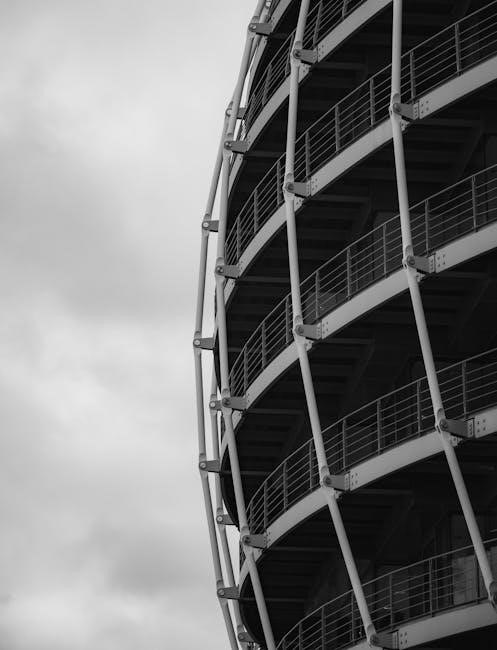ASME Section VIII Division 1 provides rules for designing, fabricating, inspecting, and testing pressure vessels, ensuring safety and compliance across various industries.
1.1 Overview of ASME Boiler and Pressure Vessel Code
The ASME Boiler and Pressure Vessel Code (BPVC) is a comprehensive standard that provides rules for the design, construction, and certification of boilers and pressure vessels. It is widely recognized as a global benchmark for ensuring the safety and reliability of equipment operating under pressure. The BPVC is divided into sections, with Section VIII specifically addressing pressure vessels. This section is further divided into three divisions, each catering to different types of vessels and operating conditions. Division 1 focuses on vessels operating at pressures exceeding 15 psig, offering detailed guidelines for materials, fabrication, inspection, and testing. The code ensures compliance with safety standards, making it essential for industries like energy, chemical processing, and transportation.
1.2 Importance of Section VIII Division 1
ASME Section VIII Division 1 is a critical standard for ensuring the safety and reliability of pressure vessels in various industries. Its guidelines are essential for preventing failures that could lead to catastrophic consequences, including loss of life and environmental damage. By providing detailed requirements for design, materials, and fabrication, it ensures that pressure vessels operate safely under internal or external pressures exceeding 15 psig. Industries such as oil and gas, chemical processing, and power generation heavily rely on this section to maintain equipment integrity. Compliance with Division 1 not only enhances operational efficiency but also builds trust with regulatory bodies and clients. Its widespread adoption underscores its role as a cornerstone of pressure vessel safety worldwide.
1.3 Scope and Application of ASME Section VIII Div 1
ASME Section VIII Division 1 applies to the construction of pressure vessels operating at internal or external pressures exceeding 15 psig. It covers both fired and unfired vessels, ensuring their safe design, fabrication, inspection, and testing. The scope includes requirements for materials, welding, and non-destructive examination, providing a comprehensive framework for compliance. This section is widely used in industries such as petroleum, chemical, and power generation, where pressure vessels are critical. By adhering to Division 1, manufacturers ensure their vessels meet rigorous safety standards, reducing operational risks and maintaining regulatory compliance. Its application is universal, making it a fundamental reference for engineers and fabricators worldwide.

Key Concepts and Definitions
Key concepts include pressure vessels, design methodologies, safety standards, and fabrication requirements, ensuring compliance with ASME Section VIII Div 1 for reliable operation and safety.
2.1 Pressure Vessels: Definition and Classification
A pressure vessel is a container designed to withstand internal or external pressure, ensuring safe operation in various industrial applications. According to ASME Section VIII Div 1, pressure vessels are classified based on their design, construction, and usage. They can be categorized as fired or unfired, depending on whether they involve heat sources. Additionally, they are grouped by types, such as cylindrical, spherical, or elliptical, reflecting their geometric shapes. Classification also considers factors like material, thickness, and maximum allowable pressure, ensuring compliance with safety standards. This systematic classification helps in applying appropriate design and fabrication rules, guaranteeing reliability and performance under specified conditions.
2.2 Types of Pressure Vessels Covered Under ASME Section VIII Div 1
ASME Section VIII Div 1 covers a wide range of pressure vessels, including cylindrical, spherical, and elliptical types. These vessels can be fired or unfired, with fired vessels involving heat sources like burners, while unfired ones rely on external pressure. Storage tanks for liquids and gases, as well as reactors and separators, are also included. The code addresses vessels fabricated from steel and other materials, ensuring their design meets safety and performance standards. This broad coverage allows the code to apply to diverse industrial applications, from petroleum refining to chemical processing, ensuring reliable and compliant vessel construction across various sectors.
2.3 Terms and Terminology Used in the Code
ASME Section VIII Div 1 employs specific terminology to ensure clarity and consistency in pressure vessel design and construction. Key terms include pressure vessel, defined as a container designed to hold gases or liquids at pressures exceeding atmospheric pressure. Design pressure refers to the maximum pressure for which the vessel is designed. MAWP (Maximum Allowable Working Pressure) is the highest pressure at which the vessel can safely operate. Allowable stress denotes the maximum stress permitted for materials under specified conditions. Other terms like welding procedures, NDE (Non-Destructive Examination), and certification marks are essential for compliance. These terms ensure precise communication and adherence to safety standards throughout the design and fabrication process.

Design Requirements and Considerations
ASME Section VIII Div 1 outlines essential design requirements, including load calculations, allowable stress values, and safety margins to ensure pressure vessels operate safely under specified conditions.
3.1 Design Methodologies and Load Calculations
ASME Section VIII Div 1 establishes design methodologies and load calculations to ensure pressure vessels withstand internal and external pressures. The code specifies methods for analyzing stress loads, including mechanical, thermal, and seismic factors. Designers must calculate maximum allowable stress values and ensure compliance with safety margins. Detailed equations and charts are provided for determining vessel thickness and reinforcing elements. Additionally, the code addresses fatigue analysis for cyclic loading conditions, ensuring long-term reliability. These methodologies are essential for maintaining structural integrity and preventing failure under operational stresses, making them critical for safe and efficient pressure vessel design.
3.2 Allowable Stress Values and Design Limits
ASME Section VIII Div 1 specifies allowable stress values for materials, ensuring pressure vessels operate safely within design limits. These values are determined based on material strength properties, such as tensile strength, and are adjusted for temperature and other operating conditions. The code establishes maximum allowable stress limits to prevent plastic deformation or failure. Design limits also account for factors like corrosion, erosion, and cyclic loading, ensuring long-term integrity. By adhering to these guidelines, engineers can select appropriate materials and design vessel components to withstand operational stresses while maintaining safety and reliability. These stress values and limits are fundamental to the code’s safety framework;
3.3 Design Factors for Different Types of Vessels
ASME Section VIII Div 1 outlines specific design factors for various pressure vessel types, such as cylindrical, spherical, and jacketed vessels. For cylindrical vessels, factors include diameter, wall thickness, and longitudinal joints. Spherical vessels require consideration of radius and weld joints. Jacketed vessels involve additional design elements for the outer shell and inner core. The code also addresses factors like openings, nozzles, and supports, ensuring structural integrity. Operating conditions, such as internal or external pressure, temperature, and cyclic loading, influence design decisions. Material properties and fabrication methods further tailor these factors, ensuring vessels meet safety and performance standards. These guidelines help engineers optimize designs for diverse applications while maintaining compliance with the code.

Materials and Fabrication
ASME Section VIII Div 1 specifies approved materials and fabrication techniques, ensuring vessels are constructed safely and reliably for their intended operating conditions and environments.
4.1 Material Selection and Specification
Material selection is critical for pressure vessel design under ASME Section VIII Div 1. The code specifies approved materials, their properties, and allowable stresses. Engineers must consider factors like operating conditions, temperature, and corrosion resistance. Materials are categorized into groups based on their mechanical properties and weldability. The code provides tables outlining maximum allowable stress values for metals at different temperatures; Compliance with these specifications ensures the vessel can withstand design loads safely. Documentation, such as material certification, is required to verify compliance. Proper material selection balances cost, performance, and safety, ensuring the vessel meets all regulatory and operational requirements.
4;2 Fabrication Techniques and Requirements
Fabrication of pressure vessels under ASME Section VIII Div 1 requires adherence to specific techniques and standards. The code outlines detailed procedures for processes like welding, cutting, and forming. Welding must comply with qualified procedures and involve certified welders. Heat treatment, when required, must follow precise temperature and time guidelines. All fabrication steps must be documented, with records maintained for traceability. The code also specifies permissible tolerances for dimensional accuracy to ensure structural integrity. Non-destructive examination (NDE) methods, such as ultrasonic testing, are mandated for critical joints. Adherence to these fabrication requirements ensures the vessel meets safety and performance standards, minimizing risks during operation.

4.3 Welding and Joining Methods
ASME Section VIII Div 1 specifies stringent requirements for welding and joining methods to ensure the structural integrity of pressure vessels. Welding procedures must be qualified in accordance with ASME Section IX, and welders must be certified to perform specific techniques. Common methods include Shielded Metal Arc Welding (SMAW), Gas Metal Arc Welding (GMAW), and Gas Tungsten Arc Welding (GTAW). The code mandates pre- and post-weld heat treatment for certain materials to prevent defects. All welds must undergo non-destructive testing, such as radiography or ultrasonic testing, to verify quality. Proper documentation of welding procedures and test results is essential for compliance and certification. Adherence to these standards ensures reliable and safe pressure vessel construction.

Inspection and Testing
ASME Section VIII Div 1 requires rigorous inspection and testing to ensure pressure vessels meet safety and design standards, including non-destructive examinations and hydrostatic tests.
5.1 Non-Destructive Examination (NDE) Methods
ASME Section VIII Div 1 mandates the use of Non-Destructive Examination (NDE) methods to ensure the integrity of pressure vessels. Common NDE techniques include radiography (RT), ultrasonic testing (UT), magnetic particle testing (MT), and liquid penetrant testing (PT). These methods detect surface and internal defects without damaging the material. Radiography uses X-rays or gamma rays to identify internal flaws, while ultrasonic testing employs high-frequency sound waves to examine thickness and detect discontinuities. Magnetic particle testing is effective for ferromagnetic materials, revealing surface and subsurface cracks. Liquid penetrant testing identifies surface defects by applying a dye that seeps into cracks. The choice of method depends on the material and construction of the vessel. NDE ensures compliance with safety standards and prevents potential failures.
5.2 Pressure Testing and Certification
ASME Section VIII Div 1 requires pressure testing to verify the structural integrity of pressure vessels. Hydrostatic testing is the preferred method, involving pressurizing the vessel with water to 1.5 times the design pressure. Pneumatic testing, using gas, is alternative but less safe. Tests ensure no leaks or deformities exist. Certified inspectors oversee these procedures to guarantee compliance. Successful testing confirms the vessel’s safety for operation, leading to certification; This step is critical for ensuring reliability and adherence to code standards, protecting both personnel and equipment from potential failures.
5.3 Documentation and Reporting Requirements
Proper documentation is essential for compliance with ASME Section VIII Div 1. It ensures traceability and verification of all design, fabrication, and testing processes. Detailed records, including design calculations, material certification, and test results, must be maintained. Non-destructive examination (NDE) reports and pressure test certificates are also required. All documents must be signed by authorized personnel and retained for future reference. Accurate reporting ensures compliance with code standards and provides a clear audit trail. Proper documentation is critical for obtaining certification and demonstrating adherence to safety and quality standards throughout the vessel’s lifecycle.

Certification and Compliance
ASME Section VIII Div 1 certification ensures compliance with established standards for pressure vessel safety. It involves rigorous inspections, adherence to design codes, and documentation to verify conformity.
6.1 ASME Certification Marks and Their Significance
The ASME certification mark is a widely recognized symbol of compliance with the ASME Boiler and Pressure Vessel Code. It signifies that a pressure vessel has been designed, fabricated, and inspected in accordance with the rigorous standards outlined in Section VIII Division 1. The mark is issued only after a thorough review and inspection by an Authorized Inspector, ensuring the vessel meets safety and performance criteria. The certification mark not only verifies compliance but also provides assurance to users and regulatory bodies of the vessel’s reliability and safety. It is a critical requirement for pressure vessels operating in industrial settings, reinforcing trust in the equipment’s integrity and adherence to international standards.
6.2 Compliance with Local and International Standards
ASME Section VIII Division 1 is recognized as an international standard, ensuring compliance with both local and global regulations. It aligns with requirements from various countries, making it a universal guide for pressure vessel construction. While the code provides comprehensive design and safety standards, manufacturers must also adhere to additional local laws and regulations. This dual compliance ensures that pressure vessels meet all necessary safety and operational criteria worldwide. The code’s alignment with international standards facilitates trade and collaboration across borders. Its provisions are often referenced or adopted by other countries, further solidifying its global acceptance. By following ASME Section VIII Div 1, manufacturers can ensure their products meet both regional and international demands, fostering confidence in their safety and reliability.
6.3 Role of Authorized Inspectors
Authorized inspectors play a crucial role in ensuring compliance with ASME Section VIII Division 1 standards. They are responsible for verifying that all design, fabrication, and testing processes meet the code’s requirements. Inspectors conduct thorough examinations of pressure vessels, including non-destructive testing and pressure testing, to ensure safety and reliability. They also review documentation to confirm adherence to specifications and maintain detailed records of inspections. Their authority extends to certifying vessels for operation, providing an independent verification of compliance. This oversight is essential for maintaining public safety and trust in pressure vessel systems. The role of authorized inspectors is integral to upholding the integrity of the ASME Boiler and Pressure Vessel Code standards globally.

Real-World Applications and Case Studies
ASME Section VIII Div 1 is widely applied in industries like oil & gas, chemical processing, and power generation, ensuring safe and reliable pressure vessel operations globally.
7.1 Industrial Applications of ASME Section VIII Div 1
ASME Section VIII Div 1 is extensively used in various industries, including oil & gas, chemical processing, and power generation, to ensure the safe design and operation of pressure vessels. These vessels are critical for storing and processing fluids and gases under high pressure. The section’s guidelines are applied to boilers, storage tanks, and heat exchangers, among other equipment, to prevent failures and ensure compliance with safety standards. Its application is vital in industries where pressure vessels operate at extreme conditions, requiring precise engineering and adherence to codes. By following ASME Section VIII Div 1, industries maintain reliability and public safety in their operations.
7.2 Case Studies: Successful Implementation and Challenges
Case studies highlight the practical application of ASME Section VIII Div 1 in real-world projects, showcasing both successes and challenges. For instance, in the oil & gas industry, pressure vessels designed under this section have successfully operated in extreme conditions, ensuring safety and efficiency. However, challenges such as complex design requirements and high fabrication costs often arise. One notable case involved a chemical plant where adherence to the code prevented a potential failure, avoiding catastrophic consequences. Despite these successes, challenges like material shortages and interpretation ambiguities have been reported. These case studies emphasize the importance of strict compliance, highlighting how proper implementation can mitigate risks and ensure operational reliability across industries.
7.3 Lessons Learned from Real-World Projects
Real-world projects utilizing ASME Section VIII Div 1 have provided valuable insights into its practical application. One key lesson is the importance of adhering strictly to design and fabrication guidelines to ensure safety and reliability. Projects involving high-pressure vessels have highlighted the need for precise material selection and advanced welding techniques. Additionally, challenges such as interpreting complex code requirements and managing fabrication costs have been common. Successful implementations often emphasize thorough non-destructive examination (NDE) and rigorous testing phases. These experiences underscore the critical role of compliance in preventing failures and ensuring operational efficiency. Ultimately, these lessons reinforce the necessity of meticulous planning and adherence to ASME standards for optimal outcomes in pressure vessel construction.

Troubleshooting and Common Issues
Common issues include design errors, material defects, and non-compliance with ASME standards. Troubleshooting involves identifying root causes and implementing corrective actions to ensure safety and reliability.
8.1 Common Design and Fabrication Mistakes
Common design and fabrication mistakes in ASME Section VIII Div 1 include incorrect load calculations, material selection errors, and noncompliance with stress limits. Improper welding techniques and insufficient inspection can lead to defects. Designers often overlook specific fabrication requirements, such as heat treatment or impact testing. Additionally, misinterpretation of design formulas and tolerances can result in non-compliant vessels. Fabrication errors may include improper fit-up, incorrect welding procedures, or inadequate post-weld heat treatment. These issues can compromise safety and lead to costly rework or failure. Adhering strictly to ASME guidelines and conducting thorough reviews is essential to minimize such mistakes and ensure pressure vessels operate safely and efficiently under specified conditions.
8.2 Troubleshooting During Inspection and Testing
During inspection and testing of pressure vessels under ASME Section VIII Div 1, common issues include surface cracks, weld defects, or improper thickness. Non-destructive examination (NDE) methods like ultrasonic testing or radiography can detect such flaws. Pressure testing may reveal leaks or deviations from acceptable pressure limits. Troubleshooting involves identifying the root cause, such as material defects or improper welding procedures. Repairs may require re-welding or replacing faulty components. Retesting is essential to ensure compliance after corrections. Documentation of findings and corrective actions is critical for maintaining compliance and traceability. Proper documentation ensures transparency and accountability, adhering to ASME standards and regulatory requirements. Timely resolution of issues prevents delays and ensures vessel safety and reliability.
8.3 Addressing Non-Compliance Issues
Non-compliance with ASME Section VIII Div 1 often arises from design, material, or testing discrepancies. Identifying such issues requires thorough audits and inspections. Corrective actions may involve redesigning components, replacing defective materials, or retesting. Documentation is crucial, detailing non-compliance, corrective measures, and retesting outcomes. Proper reporting ensures transparency and accountability, aligning with ASME standards and regulatory expectations. Addressing non-compliance promptly prevents operational delays and enhances vessel safety and reliability.

Future Trends and Updates
ASME Section VIII Div 1 will see updates in material standards, digital design tools, and streamlined certification processes, enhancing safety and efficiency in pressure vessel construction.
9.1 Upcoming Revisions to ASME Section VIII Div 1
ASME Section VIII Div 1 is set to undergo revisions in its 2025 edition, focusing on updated design formulas, material specifications, and enhanced inspection criteria. These changes aim to align with advancements in technology and industry practices, ensuring improved safety and efficiency. The revisions will also incorporate feedback from users and address emerging challenges in pressure vessel construction. Additionally, updates will include streamlined certification processes and clarified guidelines for digital design tools. These modifications reflect ASME’s commitment to maintaining the code as a global benchmark while adapting to modern engineering demands.
9.2 Advancements in Materials and Manufacturing Techniques
Recent advancements in materials and manufacturing techniques have significantly enhanced the construction of pressure vessels under ASME Section VIII Div 1; High-strength, lightweight alloys and advanced weldments are now being utilized to improve durability and reduce weight. Additionally, additive manufacturing and automated fabrication methods are gaining traction, offering precision and efficiency. These innovations not only meet the code’s stringent requirements but also support the development of more complex and high-performance vessels. Furthermore, the integration of digital tools in material selection and manufacturing processes ensures compliance and optimizes production workflows, aligning with the evolving demands of modern engineering projects.
9.3 Impact of Digitalization on Pressure Vessel Design
Digitalization has revolutionized pressure vessel design under ASME Section VIII Div 1 by enhancing accuracy, efficiency, and compliance. Advanced CAD software and finite element analysis (FEA) tools enable precise modeling and simulation, reducing design errors. Automation in design calculations and stress analysis streamlines the process, ensuring adherence to code requirements. Digital platforms also facilitate real-time collaboration among engineers, fabricators, and inspectors. Additionally, digital documentation and data management systems improve traceability and reduce administrative burdens. These advancements not only accelerate project timelines but also contribute to safer and more reliable pressure vessel designs, aligning with the evolving needs of industries and regulatory standards.